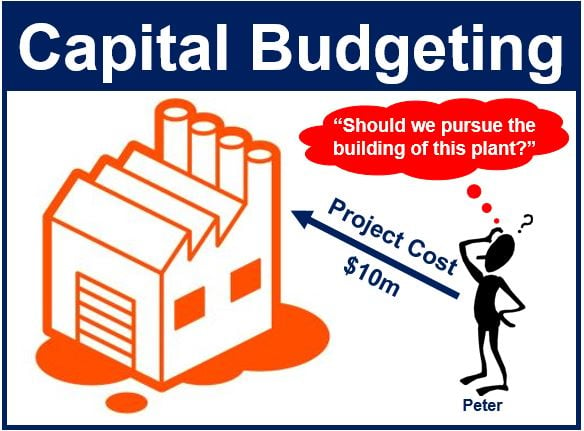Capital budgeting, also known as investment appraisal, is the planning process used to decide whether a company’s or organization’s long-term investments such as new plants, machinery, replacement machinery, new products, and R&D (research and development) projects are worth the cash funding through the business’ capitalization structure (debt, equity, or retained earnings).
In other words, it is the process of evaluating and ranking proposed projects to decide which ones merit investment. The result is intended to be a high return on funds invested.
It is the process of assigning money for major capital, or investment expenditures. One of the main aims of capital budgeting investments is to increase the firm’s value to the stockholders (shareholders).
 Peter has to decide whether the $10m spent on a new plant will provide a better return on investment than buying shares or bonds with that money.
Peter has to decide whether the $10m spent on a new plant will provide a better return on investment than buying shares or bonds with that money.
According to ft.com/lexicon, capital budgeting is:
“Capital budgeting (also known as investment appraisal) is the process by which a company determines whether projects (such as investing in R&D, opening a new branch, replacing a machine) are worth pursuing. A project is worth pursuing if it increases the value of the company.”
A project typically adds value to a firm if its **rate of return is greater than the opportunity cost. The opportunity cost of capital (hurdle rate) is what the return would have been if the money had been invested in comparable financial securities, such as bonds or shares.
** Rate of return refers to the ratio of the income we gain from an investment over its initial cost.
While the concept of capital budgeting is straightforward, it is not that easy to calculate in practice. Calculating the appropriate cost of capital is difficult. It is even harder to accurately predict how much revenue will gradually increase by thanks to the project.
Example of capital budgeting
A boatmaker has to decide whether to build a yacht for a client. Making the boat requires an outlay of $1 million upfront, and will generate revenue of $1.26 million in 12 months’ time when the customer pays for the finished product.
The return on investment (expected) is 26% per year, or ($1.26m – $1m) ÷ $1m = 0.25.
The return on this project then must be compared with the firm’s cost of capital, i.e. rather than investing in making the boat, i.e. what would the return be if the $1m outlay were invested in bonds or shares in another company?
The return from buying bonds or shares is the company’s opportunity cost of capital (assuming it has the same risk as the capital).
If the opportunity costs is less than investing $1m on making the boat, i.e. 26% per year, then the firm should approve the project. If not, the project should be turned down.
Video – What is capital budgeting?
